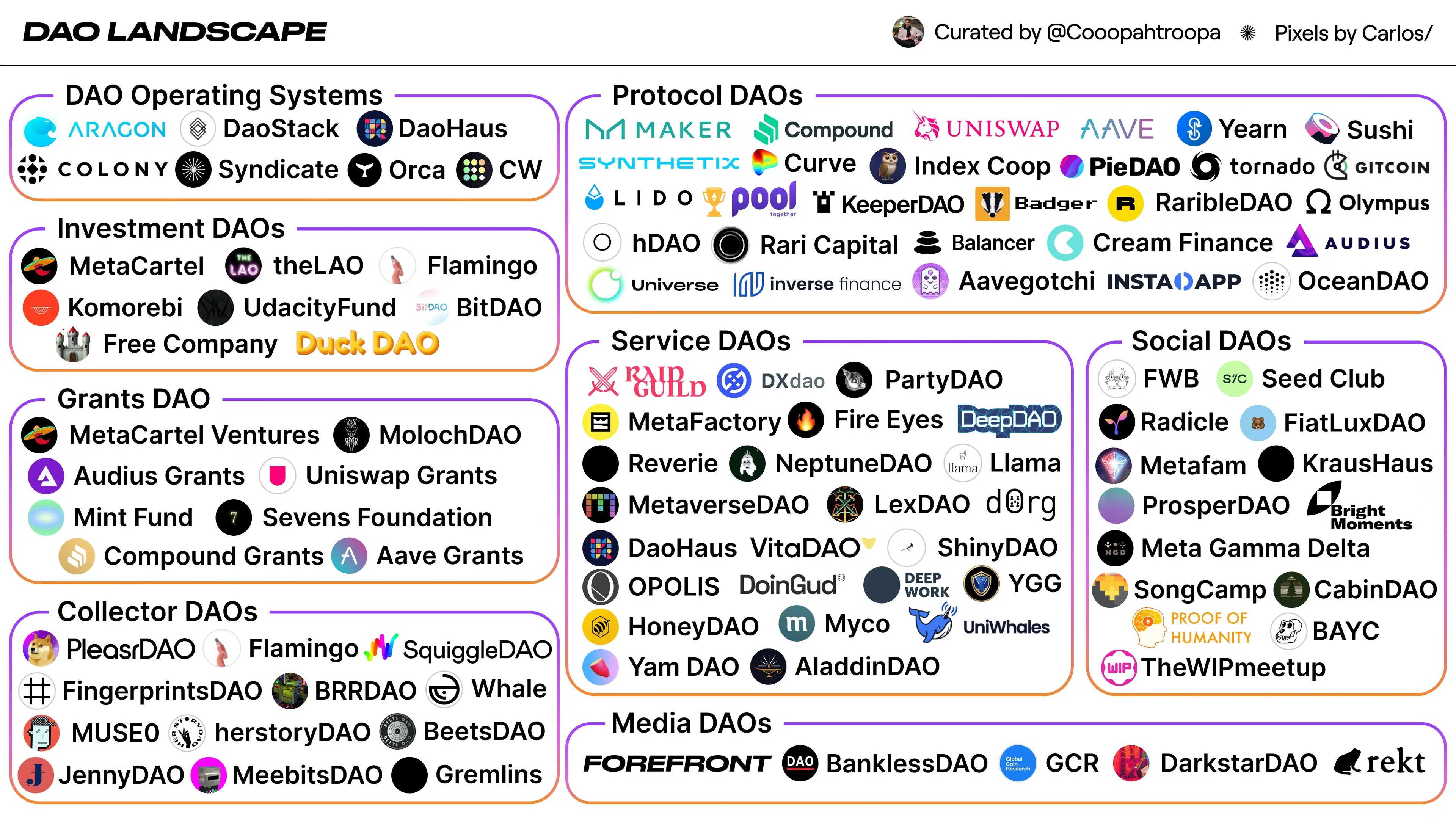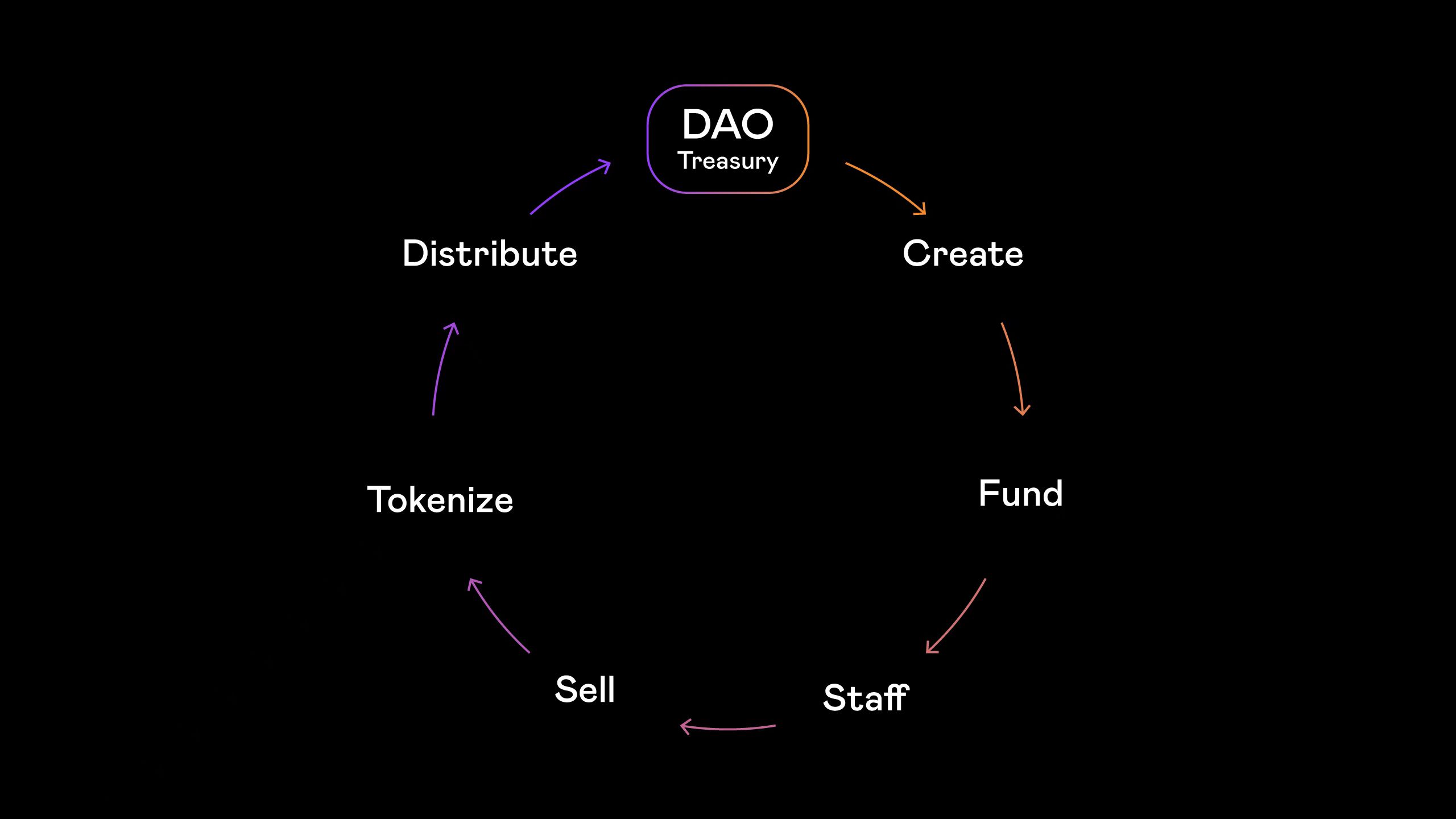This article comes fromMirrorThis article comes from

, the original author: coopahtroopa, compiled by Odaily translator Katie Koo.
In this article, we will delve into the derivatives of DAO (SubDAO, also known as sub-DAO), and how DAO will develop into a digital kingdom in the Web3 era.
secondary title
The current state of DAOs
Among the properties of most DAOs are:
treasury: manages the bank accounts of an organization, such as Gnosis Safe;
Voting: advice and governance, such as Snapshot;
Chat: for community discussions, like Discord with CollabLand or Guilds that require tokens to access;
Blog: All public-facing communications, such as Mirror.
DAOs typically have a primary asset, representing governance and ownership within the group. The asset is primarily a fungible token, although we've seen NFTs start to fill this role as well.
Together, these core mechanisms form the basis of ownership, allowing teams to grow from a small experiment into a fully self-sustainable organization.

In detail, there are many types of DAO, as shown in the figure below:
DAO is a crypto-native organization. All DAOs have some common goals:
attract new members;
Maximize the value of community wealth;
Ensuring that governance plays a meaningful role in decision-making;
Create a market for the underlying token to value ownership.
Some mainstream DAOs often have hundreds of members, a community treasury and a secondary market with a certain amount of funds. Therefore, the token price is directly related to the value of the community treasury.
DAO Tokens = Valuation of Community Treasury × Community Sentiment
We have entered a new incubation phase as the community looks to attract new members and maximize the value of their funds.
secondary title
The development prospect of SubDAO
SubDAO (child DAO) is a DAO created or derived from a parent DAO.
As DAOs grew, splinter organizations emerged that operated independently of the community. Just like when a company scales up, new departments, teams, and concerns are added to the DAO's orbit.
Rather than trying to bring all of this activity under one roof, SubDAO provides a medium for organizations to create their own foundations and ownership structures. This all happens while bringing value back to the original entity.
Fingerprints DAO → The RAWDAO
Early SubDAOs in Web3 have the following examples:
PleasrDAO → The DOGE NFT
Fingerprint is an NFT collector DAO, which differentiated The RAW DAO. All backers received $RAW tokens, and Fingerprint DAO retained 12.5% of the $RAW supply in its treasury.
Seed Club → mCLUB
After purchasing the DOGE NFT, PleasrDAO (a cultural collection organization) split the image and created $DOG. With the emergence of $DOG on the secondary market, a new DAO and organization was formed to maintain and grow the community. PleasrDAO reserves 55% of the $DOG supply.
Seed Club (a social token incubator) launched mCLUB, a DAO offering grants to Mirror creators. After a successful crowdsale, mCLUB built its team and infrastructure, while Seed Club retained 15% of the $MCLUB supply.
In these three examples, DAOs with their own tokens ($PRINTS, $PEEPS, $CLUB) create a new token ($RAW, $DOG, $MCLUB) to represent these new SubDAOs Ownership in the structure.
How DAOs Evolved
SubDAO creates value by allowing DAOs to scale.
The DAO should have a percentage of its SubDAO's position and governance in the community treasury.
Recalling our previous DAO goals:
Attract new members: SubDAO scales better by creating multiple subtasks and teams;
Maximize the value of the community treasury: SubDAO tokens increase the treasury’s NAV;
Ensuring that governance plays a meaningful role: SubDAO tokens increase the likelihood of governance within the DAO;
Create a market for sub-tokens: SubDAO tokens create additional demand for DAO tokens to expose all SubDAOs.
Additionally, SubDAO distribution should always be beneficial to DAO members, with access to early funding and monetization opportunities in the form of airdrops or in the form of whitelists.
secondary title
Principles for creating SubDAO
Each SubDAO is different from the next. Not all organizations in a DAO are necessarily suitable for developing into a SubDAO.
Some general principles for evaluating SubDAOs include:
Staff: Are there full-time contributors to this work organization?
Profit: Is this workgroup generating consistent revenue?
Novelty: Is this working group uniquely different from the parent DAO?
Sustainability: Can this working group survive on its own?
Many organizations would be better off not using it as a SubDAO. Because many back office functions are not driven by profit, but have an important role for DAO. Similarly, time-limited items (such as NFT drops) and one-time rewards would best exist as core components of a broader DAO.
secondary title
How to create a SubDAO

To create a SubDAO, follow these steps:
Create: Appoint a team leader and draft a framework for creating the organization.
Funding: Work with the team lead to request funding in USDC and native tokens (usually 50/50) from the parent DAO.
Staff: Contributor functionality for team leaders.
Sales: Allows working groups to prove their value by generating revenue for the DAO.
Tokenization: Once an organization generates more revenue in terms of funding than it initially did, assign a DAO member to create a new SubDAO directly with the team leader.
Distribution: Create new SubDAO tokens. Send a percentage of the total supply directly to the parent DAO. Distribute the remaining SubDAO tokens to contributors and a new SubDAO community treasury.
In allocating new tokens, revenue shall be split between the DAO treasury and the new SubDAO treasury.
As the sub-DAO develops, both parties are winners. If the SubDAO fails, the responsibility is limited to the organization where the SubDAO is located and its members, not the entire DAO itself.
secondary title
Stay tuned to SubDAO
The general trend of DAOs over time is to become more and more "small groups". A DAO cannot have 100,000 members join overnight.
The DAO creates ongoing value for its members by creating a dedicated "Ministry of Culture". To this end, SubDAO provides an elastic growth solution for all upcoming DAOs.
For DAO creators, embrace the request for independence. DAO does not mean dominance.
As DAOs grow in size, SubDAOs play a vital role in maintaining the core community culture. If you are a member of a DAO, find out about your community and what role its SubDAO plays in the future of the organization.





